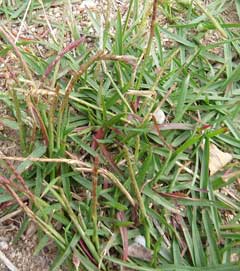 |
|
gardenology.org |
 |
| commons.wikimedia.org/wiki/User:Show_ryu |
Translate this page:
Summary
Physical Characteristics

 Zoysia japonica is an evergreen Perennial growing to 0.2 m (0ft 8in). It is in leaf all year, in flower from June to August, and the seeds ripen from June to August. The species is hermaphrodite (has both male and female organs) and is pollinated by Wind.
Zoysia japonica is an evergreen Perennial growing to 0.2 m (0ft 8in). It is in leaf all year, in flower from June to August, and the seeds ripen from June to August. The species is hermaphrodite (has both male and female organs) and is pollinated by Wind.
Suitable for: light (sandy), medium (loamy) and heavy (clay) soils and prefers well-drained soil. Suitable pH: mildly acid, neutral and basic (mildly alkaline) soils. It cannot grow in the shade. It prefers moist soil.
UK Hardiness Map
US Hardiness Map
Synonyms
Z. pungens. non Willd. Z. pungens japonica. Osterdamia japonica.
Plant Habitats
Lawn; Cultivated Beds;
Edible Uses
Edible Parts: Seed Stem
Edible Uses:
Seed[177]. No more details are given. Stem bases[177]. No more details are given.
References More on Edible Uses
Medicinal Uses
Plants For A Future can not take any responsibility for any adverse effects from the use of plants. Always seek advice from a professional before using a plant medicinally.
None known
References More on Medicinal Uses
The Bookshop: Edible Plant Books
Our Latest books on Perennial Plants For Food Forests and Permaculture Gardens in paperback or digital formats.

Edible Tropical Plants
Food Forest Plants for Hotter Conditions: 250+ Plants For Tropical Food Forests & Permaculture Gardens.
More

Edible Temperate Plants
Plants for Your Food Forest: 500 Plants for Temperate Food Forests & Permaculture Gardens.
More

More Books
PFAF have eight books available in paperback and digital formats. Browse the shop for more information.
Shop Now
Other Uses
References More on Other Uses
Cultivation details
Requires a sunny position in a well-drained soil. Frequently cultivated in warm temperate zones as a lawn grass[58, 200]. Plants are hardy to about -10°c and succeed outdoors in many parts of Britain[200].
References Carbon Farming Information and Carbon Sequestration Information
Temperature Converter
Type a value in the Celsius field to convert the value to Fahrenheit:
Fahrenheit:
The PFAF Bookshop
Plants For A Future have a number of books available in paperback and digital form. Book titles include Edible Plants, Edible Perennials, Edible Trees,Edible Shrubs, Woodland Gardening, and Temperate Food Forest Plants. Our new book is Food Forest Plants For Hotter Conditions (Tropical and Sub-Tropical).
Shop Now
Plant Propagation
Seed - surface sow in spring in a greenhouse. Germination should take place within 2 weeks, prick out the seedlings into individual pots when they are large enough to handle and plant them out in the summer. Division in spring.
Other Names
If available other names are mentioned here
Native Range
TEMPERATE ASIA: Russian Federation (Primorye), China (Zhejiang Sheng, Hebei Sheng, Jiangxi Sheng, Jiangsu Sheng, Liaoning Sheng, Shandong Sheng), Korea, Japan (Hokkaidô, Honshu, Kyushu, Shikoku), Taiwan
Weed Potential
Right plant wrong place. We are currently updating this section.
Please note that a plant may be invasive in one area but may not in your area so it's worth checking.
Conservation Status
IUCN Red List of Threatened Plants Status :

Growth: S = slow M = medium F = fast. Soil: L = light (sandy) M = medium H = heavy (clay). pH: A = acid N = neutral B = basic (alkaline). Shade: F = full shade S = semi-shade N = no shade. Moisture: D = dry M = Moist We = wet Wa = water.
Now available:
Food Forest Plants for Mediterranean Conditions
350+ Perennial Plants For Mediterranean and Drier Food Forests and Permaculture Gardens.
[Paperback and eBook]
This is the third in Plants For A Future's series of plant guides for food forests tailored to
specific climate zones. Following volumes on temperate and tropical ecosystems, this book focuses
on species suited to Mediterranean conditions—regions with hot, dry summers and cool, wet winters,
often facing the added challenge of climate change.
Read More
Expert comment
Author
Steud.
Botanical References
58200266
Links / References
For a list of references used on this page please go here
Readers comment
© 2010, Plants For A Future. Plants For A Future is a charitable company limited by guarantee, registered in England and Wales. Charity No. 1057719, Company No. 3204567.